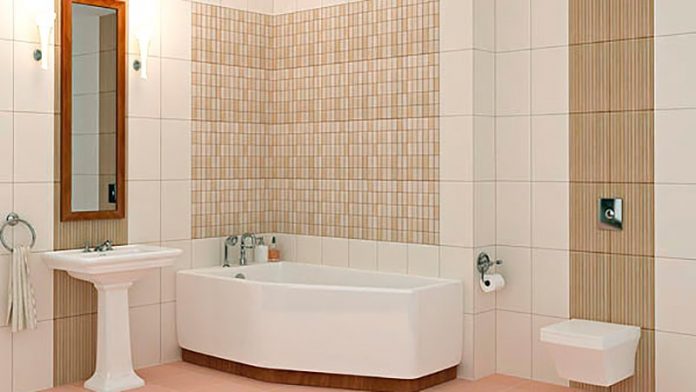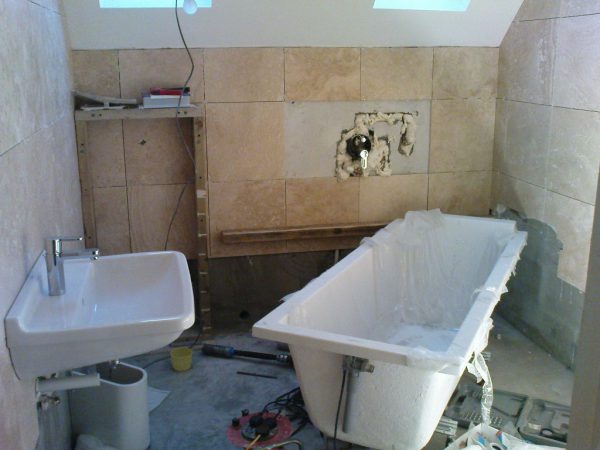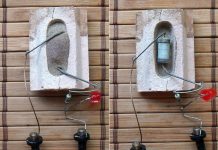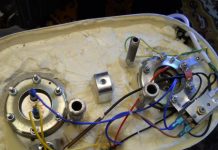Following the instructions, you will reach the final stage. At the end, install the sink, hang the mirror and lamp, install the furniture. The end result is a beautiful room.
People find it difficult to renovate a washroom. The toilet is an important part of the home, which I advise you to repair thoroughly and correctly, taking into account all the little things. How to start the painstaking process, I will tell you below.
VIDEO
Having gone the hard way, in the end you will get a result that will delight you with freshness and originality. But the thought that the author of the masterpiece is you yourself will bring more pleasure.
The combined bathroom has advantages and disadvantages. The main disadvantage is that the room is available only to one household. Plus - the ability to expand the area of the bathroom. It is easy to put a washing machine or a wardrobe in the combined bathroom.
In modern apartments, the toilet is separate from the bathroom. At the same time, the premises are characterized by a small area and there are often cases when a few centimeters are not enough to install furniture or other object. To fully consider the issue, consider how to combine a bathroom and toilet.
This kind of repair, in addition to construction work, provides for "paperwork". According to the rules, redevelopment in the apartment is coordinated with the relevant authorities. In this case, changes are made to the housing plan.
When making a preliminary plan, mark the relocation of plumbing, changes to electrical wiring, and changes to the plumbing system. This is an incomplete list of factors that should not be ignored. The work on combining a bathroom is a small technical part of a huge work.
Once you have approved the plan, switch to repairs. It is better if the household members go on a summer vacation for a while. As a result, they will protect themselves from discomfort, and no one will bother you.
Remove the partition between the bathroom and toilet, line up the walls, which are usually extremely crooked.
Redo the pipes. If necessary, change their location so that they do not interfere. The same goes for the heated towel rail.
The next step is to install electrical wiring. Route cables, locate switches and outlets, and install.
Primer the walls and level the floor with a concrete screed. Before laying the floor covering, be it tiles or other finishing material, fill the floor with bitumen. This will reduce the likelihood of neighbors flooding in the event of a leak.
Stretch ceilings are a good option for a combined unit. Only entrust their installation to professionals, since the arrangement of the ceiling involves the use of special equipment and skills.
Decorate the walls and lay the flooring. To visually expand the space of the room, embed a large mirror in each wall. The combined bathroom will turn out beautiful and original.
The final stage of the renovation involves the installation of plumbing, furniture placement, connection of household appliances, installation of bath accessories - hanging soap dishes, hooks.
If you want to achieve results, listen to the recommendations. They will help you complete the repairs quickly and successfully. When the family returns home, the beauty of the combined bathroom will surprise.
I devote the final part of the article to the layout of the bathroom and the subtleties of choosing furniture. If you have finances, organize a separate bathroom in the house, especially if the family is large. As a result, several people will be able to cope with needs at the same time. If you like a combined bathroom, make sure that it has a sliding partition. Use it to divide the room into zones.
The size of the room. To make the toilet convenient and comfortable, allocate a few square meters for the arrangement. No extra space required. Design a bathroom, guided by tastes and preferences, but you should not overdo it with space - 6-10 squares are enough.
Furniture . Before buying furniture, decide what you want to see in the room. Usually this is a set of a sink, a mirror, a pencil case and a floor stand. Sometimes a hanging cabinet is provided. Before buying a bath headset, make sure of the quality. On the surface of the furniture, paint should lie in an even layer.
Fittings. From accessories, choose models equipped with chrome-plated legs, handles and metal hinges. Fittings are also made of plastic, coated with a layer of chrome. Such furniture is not worth buying, since chrome-plated or gilded plastic handles will quickly lose their original appearance.
Sink . Be sure to inspect the sink for chips and damage. Check the integrity of the product by tapping it lightly. Buy a sink that emits a pleasant ringing boldly. A dull sound is a sign of defects.
Bedside tables and wardrobes. When choosing bedside tables and cabinets, be guided by the size of the room, the number of residents and tastes. If there is more than enough space, buy a large set that can fit a hairdryer, curling iron, shampoos and other things.If there are problems with the area, pay attention to a set of pedestals and several hanging boxes.
Shelves and niches. It is not superfluous to equip the bathroom with open or closed niches and shelves. They will help with the storage of bath utensils. Be sure to provide space for clothes and bath towels. A hanger or a set of hooks will help solve the issue.
I hope your day of knowledge was not in vain and you learned a lot of useful information.
Before starting repairs in the bathroom, you should consider the sequence of work. Without observing the technology, you can ruin the tiles laid out on the floor if you start decorating the walls. You can also damage the tiles on the walls when wiring is required. In order to get a high-quality bathroom renovation, you need to start it right, which can be found in this article.
Of the materials for the initial stage of renovation in the bathroom, you will need:
Mix for mixing concrete.
Waterproofing (roofing material, epoxy or bitumen mastic).
Pipes and hoses for pipeline construction, shut-off valve.
Cables of the required length and cross-section for electrical appliances.
Waterproofing.
The following tools will be used to carry out the work:
Putty knife.
Capacity for mixing the solution.
Scissors.
Rule.
Construction meter.
Pencil.
Brush.
After that, the required materials are calculated. And for this you need to know the size of the room. It is necessary to accurately measure the height and width of the walls, the dimensions of the ceiling and floor. After that, calculate how much tile is required on the walls and floor. You also need to consider whether you need to lay tiles behind the bath. If not, then this area must be subtracted from the calculated one. But do not forget about a small supply of materials (about 10%), which will be spent on cutting. If you decide to lay tiles, read the articles Preparing walls for tiles and How to lay tiles.
It is necessary to calculate the required amount of plaster, which will be required for a possible leveling of the walls. If the surfaces are relatively flat, then much less material will go away.
Preparing a bathroom for renovation consists of several stages:
Overlapping water.
Dismantling of old plumbing, pipes.
Dismantling the door.
Preparation of all surfaces.
The first step is to shut off the water that enters the bathroom. Only then can you dismantle all items from the room. When the room is free of unnecessary items, all surfaces are prepared.
If there are old tiles on the walls and ceiling, then it needs to be knocked down. The coating must also be removed on the painted wall. You can use special quick paint removers. If the old coating is still poorly removed, then shallow notches are made over the entire surface of the walls so that the wall becomes rough.
After carrying out the preparatory work, the following actions are performed:
The floor screed is being made.
Waterproofing is being laid.
A pipeline is being laid.
Power is supplied to the devices.
The floor screed is necessary to facilitate further tiling work. By completing this stage of work, the floor is perfectly flat. In addition to leveling, the screed provides noise and thermal insulation. This is especially important for those who live in a private house and on the ground floors of apartment buildings.
When the screed is dry, it is necessary to lay a layer of waterproofing, which will protect the floor from moisture penetration. Then the pipeline is connected to all plumbing fixtures. Water supply and drainage is provided.
The screed is only done on a clean, dry floor. All debris must be removed from the floor so that no grains of sand remain. After that, the floor is primed with a brush. Then the screed mixture is prepared.
First you need to determine the curvature of the floor. For this, a building level is used. If the floor is flat, no screed is required. When the height difference per 1 m 2 is not more than 1-2 cm, a cement-sand mortar is made.But if the curvature exceeds 2 cm, then a concrete mixture of cement, crushed stone and sand is required.
After preparing the solution, beacons are installed on the floor, along the top of which you can draw a horizontal line. If you put a building level on top of the lighthouses, then it should show a flat surface.
Then the prepared mixture is poured onto the floor in parts. It should reach the top of the beacons, but not completely. An hour later, the lighthouses are pulled out of the dried solution, and therefore it is required that the solution does not completely cover their tops.
The resulting gaps from the lighthouses are filled with a solution. After that, the room is left to dry the floor. During drying, it is better to cover the floor surface with plastic wrap, due to which the concrete will not crack.
After the concrete has dried, it is imperative to make waterproofing. This is extremely important in order to protect the concrete from absorbing excess moisture.
Waterproofing consists of the following stages:
Primers.
Preparation of material for waterproofing.
Application of a solution (or material)
First of all, the floor must be primed. When insulating floors with liquid mixtures, priming will additionally provide better adhesion.
If rolled waterproofing is used, then it is cut into sheets of the required dimensions. After that, it is laid on the floor. The sheets of material should be stacked tightly to each other. Seams should be glued with special tape.
Liquid waterproofing is applied with a brush to the entire surface. And when using pasty compositions, a spatula is used. In the first and second cases, you need to ensure that the material is applied in an even layer.
Installing piping in the bathroom is one of the most challenging tasks. The main thing in this matter is the correct drawing up of communication layouts. It has already been described above how to do this correctly.
After that, the method of laying is determined, which can be:
Open means the passage of pipes along the walls from the outside. This type is less presentable than the closure type of gasket. The last option is good because all pipes are hidden in the walls. But for this you will have to spend a lot of time, because you have to gouge the walls.
So, if an open installation type is chosen, then all pipes are laid along the walls as low as possible to the floor. When closed, it is necessary to draw the places of passage of pipes on the wall, then perform a slitting of the surface. Pipes are laid in the prepared groove, which are covered with cement mortar from above.
When installing the pipeline, it is necessary to consistently connect one of its elements with another. All connections must use a rubber gasket to protect against leaks.
The manifold type of laying implies a separate laying of pipes for each device. Due to this, a shut-off valve can be installed on each site, which will allow to shut off the water not immediately in the whole house, but only in a separate area. After laying the line, you need to check the system for leaks.
When laying electrical wiring in the bathroom, there are several points to consider:
Installation of circuit breakers.
Use of 3-core cables.
Use only protected electrical devices.
First of all, you need to calculate the load of all electrical appliances in the bathroom. To it you need to add about 25% of the stock. After that, the devices must be divided into several groups (the load of a separate group should not exceed 1.5 kW). After that, an automatic switch of the corresponding rating is installed in the electrical panel for each group of consumers.
Use only three-core cables. The 1st core is connected to the phase, the 2nd - to the neutral conductor, the 3rd - to the ground loop on the house. If such a contour is absent in an apartment building, then the core can be brought out to any metal surface, for example, to the shield door.
It is recommended to use electrical devices only with protection. The sockets must be capable of connecting to them grounding, as well as with a protective cover that protects against moisture.
Basic professional tips for initial bathroom renovations:
The first step is to level the floor.
The second stage is the connection of the water supply and electricity.
It is necessary to determine in advance the location of the plumbing, so that you do not have to redo it.
Before making repairs in the bathroom, it is recommended to watch the video instruction, which contains the step-by-step implementation of the rough work in the bathroom.
VIDEO
The initial stage of bathroom renovation is the most difficult and responsible one. Further work and the final result depend on this. Such recommendations will help to complete the rough work as efficiently as possible and help save time and material resources.
The bathroom is one of the smallest rooms in an apartment or private house in size. But, despite this size, this room is considered the most difficult from the point of view of architects.
Bathroom renovation, where to start
The first difficulty is that this is where all the layouts of engineering communications are concentrated. Any unskilled intervention in the wiring diagram will have very negative consequences for the entire structure. We will tell you how to competently solve problems with engineering communications in the article a little below.
The second difficulty is that the operating conditions for building materials, plumbing equipment and special furniture are the most difficult. Constant high air humidity, frequent direct contact of architectural elements with water and high temperatures require special materials and construction technologies. This is the only way to ensure the reliability and durability of the premises.
As with all construction work, bathroom renovations should start with planning. There are two reasons for the need to renovate the bathroom, there is a big difference between them, respectively, and the planning methodology is not the same.
The bathroom was damaged by flooding or fire. Such situations cannot be foreseen, and the consequences should be eliminated as soon as possible. Accordingly, there is no time for calm planning, decisions have to be made very quickly.
The flood always happens unexpectedly
Another major problem is finance. If you have time to carefully prepare for scheduled repairs and save money, then the consequences of the accident must be eliminated as quickly as possible.
The aftermath of the flood must be dealt with quickly
How to act in order to eliminate the consequences of emergency situations in a short time and with minimal losses? How to plan your bathroom renovation correctly?
Make an audit of the condition of equipment and building elements. Take this stage very responsibly, the more you notice the problems, the more complete the purchases can be made. And this means that there will be no need to go back to the store for every missed trifle and waste precious time.
Make an audit of the condition of equipment and building elements
Buy materials with the most similar properties
Make a work plan
When the preparatory planning stage is completed and materials have been purchased, you can begin repair work.
The situation is much calmer, there is time to think over and weigh everything in detail. What is recommended to consider when planning a renovation?
Consider your financial capabilities. At the same time, add up the price of all materials and the cost of their installation. If the repair is major, then you need to calculate the number and cost of re-equipment or installation of new engineering networks.The list of works includes the dismantling of old equipment and finishing materials (in the case of a major overhaul), preparation of wall, floor and ceiling surfaces, installation of water supply and sewerage, electrical wiring, installation of plumbing equipment and surface finishing. The specific list largely depends on the selected building materials and technologies.
Assess your financial capabilities
Consider the cost of plumbing or construction services
Draw a sketch of the room
Check the condition of the walls and choose materials for leveling, finishing
Only after clarifying all the questions, you can proceed to the direct repair of the premises.
The scheme of actions may change slightly, taking into account the peculiarities of the repair and the condition of the room. But for most cases, bathroom repairs need to be done in this sequence.
Step 1. Dismantling of old wall, ceiling and floor cladding. Use an electric hammer drill or manually remove the wall cladding. Don't try to preserve old ceramic tiles. Firstly, it is unlikely that it will be possible to reuse it due to its very unsightly appearance. Secondly, you can never predict how many pieces will remain intact and how many will have to be broken. Thirdly, the time spent on neatly knocking down old tiles can be used more rationally.
Step 2. Dismantle old plumbing and sewerage systems.
Important. If personal knowledge in plumbing intricacies is not enough, then we strongly recommend consulting a professional. Unskilled intervention in the installed heating, water supply and sewerage systems can completely disable them.
Cut metal pipes with a grinder, put the waste in one place. If the rest of the rooms are residential, then take measures to prevent the spread of dust. Always close the door, prevent drafts, cover furniture with plastic wrap. You will have to wear a respirator in the bathroom.
Step 3. Find out the location of the old wiring. This is not as difficult as it seems, but only if the wiring is laid in compliance with the PUE. Knowledge of the hidden wiring diagram will allow you to avoid many unpleasant situations during wall chasing or plaster removal.
How do I find the wiring in the wall?
How to find out the location of the wiring under the plaster?
Find the wiring box on the wall, it should be under the ceiling. In the wiring box, several conductive cables converge, it has holes for their output. Modern boxes are made of plastic, in old houses there are iron ones.
Find all switches and sockets on the wall, and on the ceiling where you connect the lighting fixtures. One of the main rules for installing electrical wiring is that all cables should be bent only at right angles, in direction they can only be vertical or horizontal.
Draw vertical lines from sockets and switches, draw a horizontal line under the ceiling from the distribution box. There should be wiring in the plaster along these lines. To be sure, deviate from them by 5-10 cm in each direction. The fact is that not all electricians are conscientious about their duties, in order to exclude damage to cables it is better to make a margin.
Thus, you will find out where you can hammer in the plaster without fear, and in which places to be extra careful. But in any case, before starting work, you should turn off the machine in the bathroom.
Work on the installation of electrical wiring
Step 4. Install new wiring, sewer and water pipes. We strongly recommend placing all pipes under the wall cladding. The work is much easier if the walls are finished with different slabs.
Important. Before installing pipes and electrical wiring on the wall, you need to indicate the location of the switches and sockets, the connection points for the sink and bathtub.It is advisable to know the dimensions and features of plumbing, taking into account these data, you can accurately calculate the height of the location of water sockets and drains. Due to this, installation work will be accelerated, and the reliability of fixing plumbing will increase.
Step 5. Start leveling the ceiling, walls and floor. For the floor, professionals recommend using cement screeds, they have the highest performance indicators. If you plan to make a heated floor, then you need to take into account the total thickness of the cake and mark the position of the tiles on the wall from it.
For leveling, you need to prepare a container, a spatula, a level, a tape measure
The leveled walls are moistened during the drying period of the mixture
Step 6. After the screed has completely hardened, start laying the partitions. Their location should take into account the size of the bath or shower stall, the layout of the room, the presence of additional architectural elements, etc. merits.
First, beat off the position of the first row of blocks on the floor, check all dimensions and angles. Be sure to control the position of each row of blocks, it is better to lay them under the rope. To increase the stability of the partition across the row, tie the blocks with a perforated metal tape, fix it with self-tapping screws of the appropriate length. Use the same metal tapes to fasten the blocks to the main walls of the bathroom.
Video (click to play).
Step 7. Begin the installation of sewer pipes. If you are doing a major overhaul of a room, then you should study the purpose of each existing branch, otherwise you can turn off other rooms of the apartment or house. It is better to use plastic pipes. Connect them into a socket, for sealing all additional elements have rubber gaskets. The pipes are fixed to the wall with special clamps. If finishing plastering is planned, then walls need to be channeled under the pipes. The location of the electrical cables, drawn earlier on the wall, increases the safety of the work.












